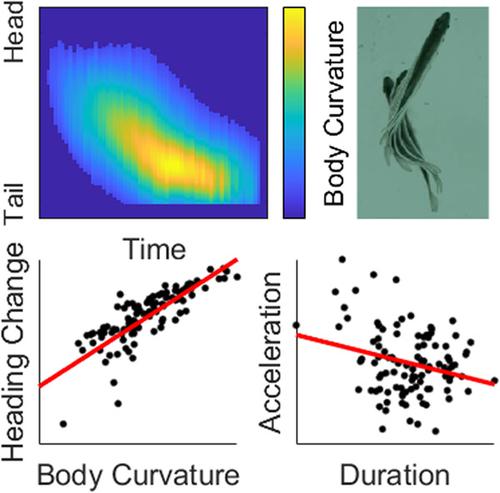当前位置:
X-MOL 学术
›
J. Exp. Zool. Part A
›
论文详情
Our official English website, www.x-mol.net, welcomes your
feedback! (Note: you will need to create a separate account there.)
The control of routine fish maneuvers: Connecting midline kinematics to turn outcomes.
Journal of Experimental Zoology Part A ( IF 1.9 ) Pub Date : 2020-07-22 , DOI: 10.1002/jez.2398 Stephen P Howe 1 , Henry C Astley 1
Journal of Experimental Zoology Part A ( IF 1.9 ) Pub Date : 2020-07-22 , DOI: 10.1002/jez.2398 Stephen P Howe 1 , Henry C Astley 1
Affiliation

|
Maneuverability is an important factor in determining an animal's ability to navigate its environment and succeed in predator–prey interactions. Although fish are capable of a wide range of maneuvers, most of the literature has focused on escape maneuvers while less attention has been paid to routine maneuvers, such as those used for habitat navigation. The quantitative relationships between body deformations and maneuver outcomes (displacement of the center of mass and change in trajectory) are fundamental to understanding how fish control their maneuvers, yet remain unknown in routine maneuvers. We recorded high‐speed video of eight giant danios (Devario aquepinnatus) performing routine and escape maneuvers and quantified the deformation of the midline, the heading of the anterior body, and the kinematics of the centroid (a proxy for center of mass). We found that both routine and escape behaviors used qualitatively similar independent body bending events, which we curvature pulses, that propagate from head to tail but show quantitative differences in midline kinematics and turn outcomes. In routine maneuvers, the direction change and acceleration of the fish are influenced by both the magnitude of the bending pulse and by the duration of the pulse, whereas in escape maneuvers, only pulse duration influenced direction change and turn acceleration. The bending pulse appears to be the smallest functional unit of a turn, and can function independently or in combination, enabling a fish to achieve a wide range of complex maneuvers.
中文翻译:

例行鱼类操纵的控制:连接中线运动学以转向结果。
可操作性是确定动物在环境中导航并成功实现食肉动物与猎物相互作用的能力的重要因素。尽管鱼类具有多种机动能力,但大多数文献都集中在逃生机动上,而对常规机动(例如用于栖息地航行的机动)的关注则较少。身体变形和操纵结果(质心的位移和轨迹的变化)之间的定量关系对于理解鱼如何控制其操纵至关重要,但在常规操纵中仍然未知。我们录制了八只巨型danios(Devario aquepinnatus)进行例行和逃生演习,并量化中线的变形,前身的航向和质心的运动学(质心的替代物)。我们发现常规行为和逃避行为都使用定性相似的独立身体弯曲事件,即我们的曲率脉冲,它们从头到尾传播,但在中线运动学和转弯结果中显示出数量差异。在常规操纵中,鱼的方向变化和加速度受弯曲脉冲的大小和脉冲持续时间的影响,而在逃避操纵中,仅脉冲持续时间影响方向的变化和转向加速度。弯曲脉冲似乎是转弯的最小功能单元,可以独立运行或组合运行,
更新日期:2020-07-22
中文翻译:

例行鱼类操纵的控制:连接中线运动学以转向结果。
可操作性是确定动物在环境中导航并成功实现食肉动物与猎物相互作用的能力的重要因素。尽管鱼类具有多种机动能力,但大多数文献都集中在逃生机动上,而对常规机动(例如用于栖息地航行的机动)的关注则较少。身体变形和操纵结果(质心的位移和轨迹的变化)之间的定量关系对于理解鱼如何控制其操纵至关重要,但在常规操纵中仍然未知。我们录制了八只巨型danios(Devario aquepinnatus)进行例行和逃生演习,并量化中线的变形,前身的航向和质心的运动学(质心的替代物)。我们发现常规行为和逃避行为都使用定性相似的独立身体弯曲事件,即我们的曲率脉冲,它们从头到尾传播,但在中线运动学和转弯结果中显示出数量差异。在常规操纵中,鱼的方向变化和加速度受弯曲脉冲的大小和脉冲持续时间的影响,而在逃避操纵中,仅脉冲持续时间影响方向的变化和转向加速度。弯曲脉冲似乎是转弯的最小功能单元,可以独立运行或组合运行,











































 京公网安备 11010802027423号
京公网安备 11010802027423号